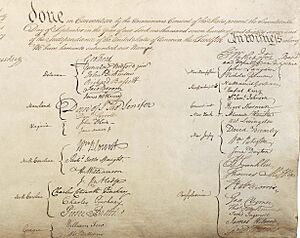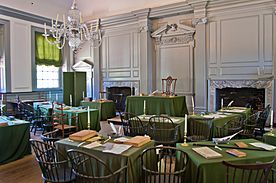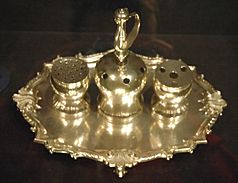Signing of the United States Constitution facts for kids
The Signing of the United States Constitution happened on September 17, 1787. This important event took place at Independence Hall in Philadelphia, Pennsylvania. Thirty-nine delegates from 12 states signed the Constitution. Only Rhode Island did not send delegates.
The Constitution was created during a four-month meeting called the Constitutional Convention. When the delegates signed it, they were saying that their work was finished and they agreed with the final document. The secretary of the convention, William Jackson, also added a note about some small changes made by hand to the document. He signed this note to show it was real.
The words used for the signing were chosen carefully by Gouverneur Morris and suggested by Benjamin Franklin. They wanted the words to be a bit unclear. This was done to encourage delegates who had doubts to still sign. The people who supported the new government knew it would be hard to get all the states to agree. They really wanted everyone at the convention to support it. They worried that many delegates might not agree to the Constitution on their own. So, they came up with the phrase, Done in convention by the unanimous consent of the states present... This made it seem like everyone agreed.
The U.S. Constitution sets up how the nation's federal government works. It explains the three main parts: the legislative (makes laws), the executive (carries out laws), and the judicial (interprets laws). Most of the signers had been part of the American Revolution. Seven of them had signed the Declaration of Independence. Thirty had served in the military. They were leaders from different parts of American society in the 1700s. Many had experience in local or state government. Jonathan Dayton, at 26, was the youngest to sign. Benjamin Franklin, at 81, was the oldest.
Contents
What the Signers Agreed To
The final words of the Constitution, which the delegates signed, said: "Done in Convention by the Unanimous Consent of the States present the Seventeenth day of September in the year of our Lord one thousand seven hundred and Eighty seven and of the Independence of the United States of America the Twelfth. In witness whereof We have hereunto subscribed our Names." This means they finished the Constitution on September 17, 1787, and signed their names to show they agreed.
George Washington signed first as the President of the Convention. He was from Virginia.
Here are some of the delegates who signed, grouped by their states:
- Delaware: George Read, Gunning Bedford Jr., John Dickinson, Richard Bassett, Jacob Broom
- Maryland: James McHenry, Daniel of St. Thomas Jenifer, Daniel Carroll
- Virginia: John Blair, James Madison
- North Carolina: William Blount, Richard Dobbs Spaight, Hugh Williamson
- South Carolina: John Rutledge, Charles Cotesworth Pinckney, Charles Pinckney, Pierce Butler
- Georgia: William Few, Abraham Baldwin
- New Hampshire: John Langdon, Nicholas Gilman
- Massachusetts: Nathaniel Gorham, Rufus King
- Connecticut: William Samuel Johnson, Roger Sherman
- New York: Alexander Hamilton
- New Jersey: William Livingston, David Brearley, William Paterson, Jonathan Dayton
- Pennsylvania: Benjamin Franklin, Thomas Mifflin, Robert Morris, George Clymer, Thomas FitzSimons, Jared Ingersoll, James Wilson, Gouverneur Morris
William Jackson, the secretary, also added a note about small changes made to the document. He signed it to confirm these changes.
How the Constitution Was Written
On July 24, 1787, the delegates chose a "Committee of Detail." Their job was to write a first draft of the Constitution. This draft was based on the decisions the convention had made so far. It had 23 articles and a preamble (an introduction). The committee's draft mostly followed the convention's ideas, but some parts were reworded.
The committee kept meeting until early September. They discussed the draft Constitution section by section. They paid attention to small details and made more compromises.
On September 8, 1787, a "Committee of Style" was formed. This committee had different members. Their job was to create the final version of the Constitution from the 23 approved articles. The final draft was shown to the convention on September 12. It had seven articles, a preamble, and a closing statement. Gouverneur Morris wrote the closing statement very cleverly to make the Constitution seem like everyone agreed. The committee also wrote a letter to send with the Constitution to the Congress of the Confederation.
The final document was carefully written out by Jacob Shallus. It was discussed on Monday, September 17, at the last meeting of the Convention. Some delegates were not happy with the many compromises in the final document. They felt these compromises made it less perfect.
Even Alexander Hamilton called the Constitution "weak." Others thought it was a betrayal of liberty. Most delegates, like James Madison, just hoped this practical Constitution would last for a generation. It was designed to meet the needs of 13 states with about four million people.
In total, 12 of the 13 states sent delegates to the Constitutional Convention. Seventy-four people were chosen, 55 attended, and 39 signed. Some people left before the signing. Three delegates who stayed refused to sign. Benjamin Franklin summed up how many signers felt. He said, "There are several parts of this Constitution which I do not at present approve, but I am not sure I shall never approve them." He accepted it because he didn't expect anything better and wasn't sure it wasn't the best.
Why the Endorsement Was Important

The closing part of the U.S. Constitution, where it was signed, mainly serves to prove it's real. It doesn't give powers to the government or limit what the government can do. But it's important proof that the Constitution is valid. It's like saying, "This is what we all agreed to." It shows who signed, when, and where. It also explains the role of the signers in creating the document. Because its job is mostly to confirm the document, it's often overlooked. Courts have never used it to make a legal decision.
On the last day of the Convention, Benjamin Franklin gave a speech (read by James Wilson) strongly supporting the Constitution. He wanted to get critics on board and create a feeling of agreement. Franklin then suggested that the delegates sign as witnesses to the states' agreement, not on behalf of their states. The convention agreed. So, the signers put their names down as witnesses to what was done at the convention. They didn't sign for their specific states, like they had for the Articles of Confederation. The signers' names are grouped by state, from north to south. Only George Washington, as president of the Convention, signed separately.
Who Were the Signers?
Seventy-four people were chosen to attend the Constitutional Convention. But some couldn't come or chose not to. Fifty-five delegates actually took part. Thirteen of them left early, either for personal reasons or because they disagreed with decisions. Three delegates stayed until the end but refused to sign the final document.
Thirty-nine delegates' names are on the Constitution. John Dickinson was sick, so he allowed George Read to sign for him. William Jackson, the convention's secretary, wasn't a delegate, but he signed the document to confirm some corrections. George Washington, as the Convention's president, signed first. Then the other delegates signed, grouped by state from north to south. Washington signed near the right side of the page. When they ran out of space, they started a second column of signatures on the left.
Jonathan Dayton, at 26, was the youngest signer. Benjamin Franklin, at 81, was the oldest. Franklin was also the first signer to die, in April 1790. James Madison was the last, dying in June 1836. Almost every signer had been part of the Revolution. At least 29 had served in the Continental Army, many as commanders. All but seven were born in the 13 colonies. Pierce Butler, Thomas Fitzsimons, James McHenry, and William Paterson were born in Ireland. Robert Morris was born in England. James Wilson was born in Scotland. Alexander Hamilton was born in the West Indies.
Documents Sent with the Constitution
When the Constitutional Convention ended on September 17, 1787, William Jackson was told to take the Constitution to Congress in New York City. He also carried two letters. One was a resolution from the delegates. It asked Congress to receive the Constitution and send it to the states for their approval. The other letter was written by George Washington on behalf of the delegates. It was sent to Arthur St. Clair, who was the President of the Continental Congress, about the proposed Constitution.
| Resolution to the Continental Congress | |
|---|---|
|
| Letter to the President of the Continental Congress | |
|---|---|
|
See also
 In Spanish: Anexo:Signatarios de la Constitución de Estados Unidos para niños
In Spanish: Anexo:Signatarios de la Constitución de Estados Unidos para niños





